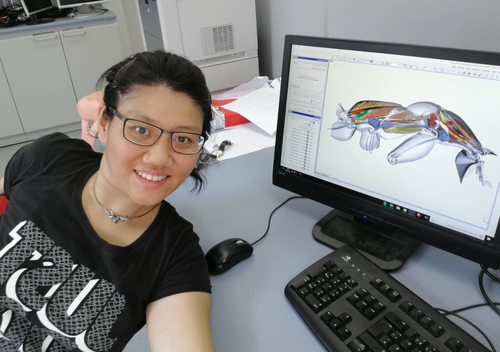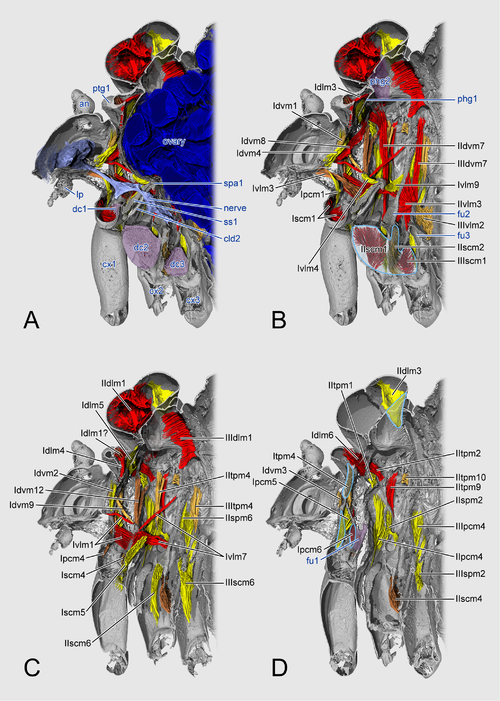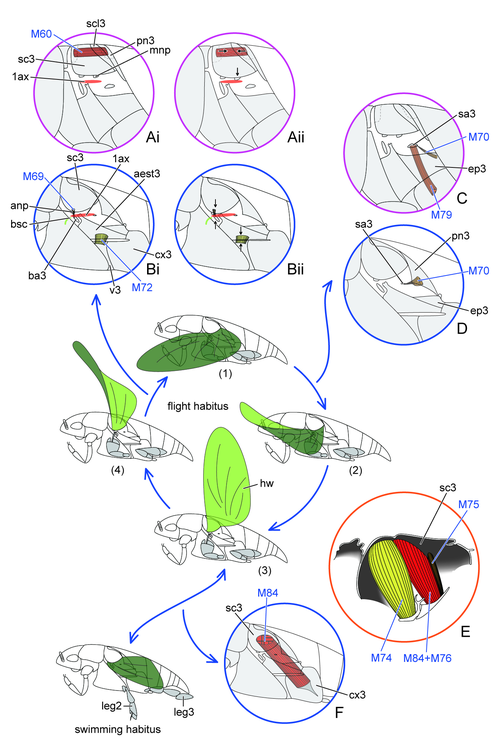This post was written by LIU Si-Pei.
 To adapt to different environments, some of the BIG4 insects - which usually fly well - abandon their flight ability and develop some other specialised structures. With modern morphological techniques such as scanning electron microscope (SEM), computer based 3D-reconstruction and traditional hand drawings, I demonstrated these specialized thoracic structures in detail.
To adapt to different environments, some of the BIG4 insects - which usually fly well - abandon their flight ability and develop some other specialised structures. With modern morphological techniques such as scanning electron microscope (SEM), computer based 3D-reconstruction and traditional hand drawings, I demonstrated these specialized thoracic structures in detail.
The reduced or absent flight related skeletomuscular structures are generally significant thoracic features of flightless insects. Meanwhile, some other modified body structures such as enlarged female ovaries, highly movable coxal articulations, etc., become a trade-off for the adaptation to specialized environments.
I am very happy that I could broaden my vision on entomology thanks to BIG4. As a PhD student in a morphological laboratory, I was deeply shocked by all the other subjects including phylogenomics, computer-based publication, mathematics etc.
The interdisciplinary approach motivated me to learn many new perspectives and to figure out how to combine the traditional morphological research with different fields. I began to realise that learning new things is a mission of my whole life.
Currently, I am dealing with a very interesting non-biting midge (Chironomidae), which lives on the ocean surface and has no flight ability. I would like to demonstrate the thoracic structure and compare that with the other alate families of "lower Diptera", and then find out the most specialized characteristics of this species.

Wingless female Nyssiodes lefuarius (Lepidoptera: Geometridae) has a very narrow thorax and enlarged ovaries (3D reconstruction)

How the Orectochilus villosus (Coleoptera: Gyrinidae) fly based on its simplified thoracic structures (hand drawing)
Besides anatomy, I also analyzed the morphological evolution of Lepidoptera and Hippoboscidae, based on parsimony. Important changes in the thoracic characters system are linked to the evolution of basal Lepidoptera. The monophyly of Hippoboscoidea, Pupipara and bat flies group are confirmed based on 44 thoracic morphological characters, which are nearly the same as the phylogenomic results. Meanwhile, the structure replacement is another interesting topic. I analyzed a whirligig beetle species (Gyrinidae), which has very simplified thoracic structures to support the flight ability. I also inferred the functions of some reduced sclerites or muscles replaced by others.
BIG4 was also a brilliant chance for me to make so many friends around world! We come together and freely discuss our researches, ideas and career expectations.
Publications within Si-Pei's project:
- Liu, S.-P., Wipfler, B., Niitsu, S. & Beutel, R.G. (2017) The thoracic anatomy of the male and female winter moth Nyssiodes lefuarius (Lepidoptera: Geometridae) and evolutionary changes in the thorax of moths and butterflies. Organisms Diversity & Evolution, 17(3): 565–594.
- Liu, S.-P., Wipfler, B. & Beutel, R.G. (2018) The unique locomotor apparatus of whirligig beetles of the tribe Orectochilini (Gyrinidae, Coleoptera). Journal of Zoological Systematics and Evolutionary Research, 56(2): 196–208.
- Liu, S.-P., Friedrich, F., Petersen, D.S., Büsse, S., Gorb, S.N. & Beutel, R.G. The thoracic anatomy of the swift lousefly Crataerina pallida (Diptera) – functional implications and character evolution in Hippoboscidea. Zoological Journal of the Linnean Society. (https://doi.org/10.1093/zoolinnean/zly032)
- Liu, S.-P., Richter, A. & Beutel, R.G. The thoracic anatomy of Myrmecia nigrocincta workers and evolutionary transformations in Formicidae (Hymenoptera). Arthropod Systematics & Phylogeny. (submitted)
- Beutel, R.G., Pohl, H.W., Yan, E.V., Anton, E., Liu, S.-P., Slipinski, A., McKenna, D. & Friedrich, F. The phylogeny of Coleopterida (Hexapoda) – morphological characters and molecular phylogenies. Systematic Entomology. (in press)

